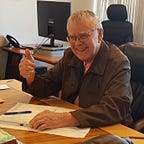Imagined Realities
Excerpt from Arthur Thormann’s book called Imagined Realities
People will imagine all sorts of things, which they will try to connect to realities. They’ll imagine their creation and the one who might have created them, and even the one who might have created their creator. They’ll imagine what their afterlife might be like, even when there might not be an afterlife. They’ll imagine how their lives might end, and so on. Imagined realities are, after all, more enjoyable than realities often are. Sometimes, people will even try to imagine the unimaginable, such as zero and infinity.
A friend of mine sent me a book by Roger Penrose called The Road to Reality. The friend wanted me to read what Roger Penrose had to say about zero. However, what interested me more was the title of the book: if we were on the road to reality, where, in fact, were we? As Penrose says in the final chapter:
“I hope it is clear, from the discussion given in the previous sections, that our road to understanding the nature of the real world is still a long way from its goal. Perhaps this goal will never be reached, or perhaps there will eventually emerge some ultimate theory, in terms of which what we call ‘reality’ can in principle be understood. If so, the nature of that theory must differ enormously from what we have seen in physical theories so far.”
In other words, Penrose is saying we do not understand reality, and perhaps never will understand it, unless some theory comes up to help us understand it. So, are we, perhaps, being still stuck in a sphere of unreality, and traveling on the road to reality? Of course, Penrose’s reality consists of a mathematical reality, which is quite foreign to the rest of us mortals. By the way, Penrose did not say much about zero.
I want to mention two aspects for you to think about: The first is an unimaginable, like zero! If you try to think of nothing at all, you’ll find it impossible! The second aspect is either nonexistent or unknowable; however, you can create an imaginable reality for this aspect; for example, for God you can create a kindly old man with a white beard; for heaven, you can create a calm and sunny countryside; for the devil, you can create a fierce creature with horns and a tail; for angels, you can create young girls in white robes with wings on their backs; and so on. Thus, the unknowable, which may also be nonexistent, can be given an imaginable reality, without ever having a known reality!
This book is about imagined realities. The reality is that most realities are preceded by imagined realities: whether imagining winning a bet in a casino; whether imagining being protected by fail-safe measures; whether imagining being resigned to things that happen; whether imagining that risks in business affect only others; whether imagining that life goes on forever; whether imagining that the future will be better or worse than the past; and so on; all these imagined realities hope for some reality.
Wherever possible, I tried to give illustrations of my own imagined realities. For example, when I listened to my Sunday school teacher describing heaven, and how we would end up there if we lived a life without sin, this led to an imagined reality that I could actually end up in such a wonderful place, although I realized later in life that this imagined reality may, in fact, never become a reality. This could also be so with many other imagined realities, such as the hope of being reincarnated.
Nevertheless, imagined realities that eventually end up in realities are very useful to the development and progress of the human race — to wit, all the imagined inventions.
Imagined realities often support feelings of hope. When a person is in hospital with a serious illness, it is his or her imagined reality that creates a future of wellness, or it is his or her assurance of friends that all will be fine. Also, when a person goes on a vacation, hoping to visit a country with a warmer climate, his or her imagined reality supports that hope. It can be a healthful imagined reality, even if it never leads to a reality.
The reality is that an imagined reality precedes a reality, if the reality exists at all, but the imagined reality can easily be an illusion, a fantasy, a dream, or a figment of one’s imagination. I hope you will enjoy the examples of imagined realities that I provided you in this book, but please remember that not all imagined realities will end up in realities.
Many years ago when I wrote my poems, they were full of imagined realities, and I decided to include some excerpts of them in an appendix of this book. I’ll give you an example:
Forlorn I sit upon the beach / and let the waves engulf my feet; / my heart is out there with the maids; / my spirit’s singing with a beat. / And soon my being is engulfed / by waters of emotions torn / between realities and dreams, / and soon I feel I’m not yet born.
Well, enjoy your own imagined realities. Perhaps most of them will become pleasant realities.
